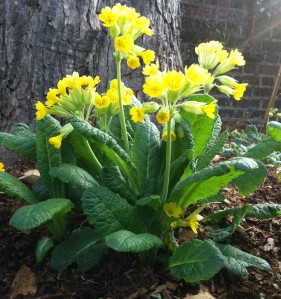We’ve had some perfect weather for flowers, warm and wet with a dash of sunshine! So let’s get looking shall we?
It’s definitely time to start looking for those flowers!
And with that said, these are the flowers you need to be looking out for this month.
Bluebell: This flower does not really need describing, for it is as well-known as the daisy. Its stalk of beautiful blue bells rises from the bulb, and fills the woods with fragrance. Count the six petals, joined into a bell. Notice the long, strap-shaped leaves, which look as if someone had folded them in half, for they have a crease down the middle.

- Bluebells from http://www.lucypaintbox.org.uk
Dandelion: Another well-known flower, with its big golden heads showing on the bank and way-side. The big head is made up of a great many florets in the form of flower-tubes. Pick a dandelion, and pull out one of the strap-shaped florets. Notice the toothed leaves, which give the plant its name – dandelion means dents-de-lion, lion’s teeth. Notice to the hollow stalk, with a milky juice inside. Watch for the beautiful “clocks” that are the seed heads of the ripened flower.

Dandelion flower and seed head. From http://www.publicdomainpictures.net
Cowslip: We all know the dancing cowslip, nodding so gaily in the wind on the hillside and in the fields. Look at the loose cluster of lemon-coloured flowers at the top of the stout stalk, each set in a pale-green calyx cup. Notice the nick in the outer edge of the petals and the bright red-orange spot at the base. The leaves will remind you of the primrose’s for they are crinkled all over.

Cowslip by http://www.bridiehall.com
Meadow buttercup: There is no mistaking the golden, polished cup of this meadow buttercup, which so often makes a carpet of gold in our fields. Notice the deeply cut-up leaves, covered with soft hairs.

Meadow buttercup by http://www.hawk-conservancy.org
Red clover: Look at the pinkish-purple heads, and notice that they are made up of thirty or more tiny flowers that belong to the sweet-pea family. If you pull out one or two, you will see the resemblance to the sweet-pea. Notice the trefoil leaves – that is, the leaves growing in groups of three. Tre means three, and foil means leaf – trefoil, three-leafed.
Scarlet pimpernel: A small plant, growing by the wayside. It is easily known because of its bright scarlet flowers. They have fine round petals. Notice the small, oval leaves. Turn them over and see the little dots on the under surface. This flower shuts its petals up in bad weather.

Scarlet pimpernel by http://4.bp.blogspot.com
Tufted vetch: We have many of these little sweet-pea-like flowers, called vetches. The tufted vetch is one of the commonest. See if you can find it growing in the hedge. It has a tuft of bright-blue or purple flowers, shaped like tiny sweet-peas. Notice the pea-pods that grow when the flower has faded, each with a curly tail. Notice the pairs of strap-like leaflets, and the tendrils that help the plant climb upwards.

Tufted vetch by http://www.plantlife.org.uk
Heart’s-ease, or wild pansy: This is a very easy plant to know because it is exactly like miniature pansy. It grows in the fields or by the wayside. It has five petals, two of purple and three of orange-yellow. The leaves are oval-shaped with wavy edges.

Wild pansy or heart’s-ease by http://www.organicsoul.com
Red campion, white campion: The red campion likes a damp place to grow in, so look for it by the streams or in ditches, or in shady hedges. It is a tall flower deep rose-red in colour. There are five petals, deeply nicked, lying flat at the top of the sepal-cup. Notice the red, sticky stem, and the leaves that grow opposite one another in pairs, set close to the stem.
The white campion is much the same as the red, but has white flowers.

Red campion by http://www.pyb.co.uk
Ribwort plantain: This is the flower that boys and girls play “soldiers” with. I expect that you know how to play. You pick the stout plantain head, and then try and strike off the head of your friends plantain with it. If you fail, your friend has a turn with his. The flowers are set close together in brown, cone-shaped heads. You may see the yellow heads of the stamens standing out of this brown head. Notice the narrow pointed leaves, growing in a circle from the root. Look at the long “ribs” running up the leaves. These “ribs” give the plant its name of ribwort.

Ribwort by http://s0.geograph.org.uk
Yarrow, or milfoil: Look for this plan in fields or waste places. Although you might not think so, it belongs to the daisy family. Look at the clusters of flowers at the top of the stiff woody stem – they are just like tiny white daisies. Notice the very much cut-up leaves – they are so much divided that the leaf seems as feathery as a fern.

Yarrow by http://www.flowersociety.org
And there you have them. May’s flowers. Sorry they are a bit late, but things got in the way. However, have fun trying to find these beauties and I’ll be back with June’s flowers soon!


